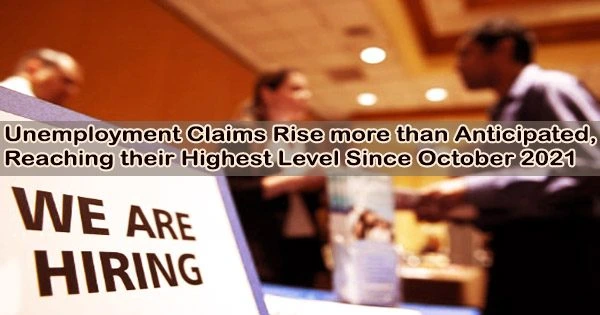Last week saw a dramatic increase in first-time unemployment claims, which could be a sign that the labor market is beginning to loosen up after more than a year of interest rate increases.
The Labor Department reported on Thursday (June 8, 2023) that the number of initial applications for unemployment benefits increased by 28,000 to a seasonally adjusted 261,000 for the week ending June 3.
The total was well ahead of the Dow Jones estimate for 235,000 and was the highest weekly rate since Oct. 30, 2021.
That weekly jump pushed up the four-week moving average of claims by 7,500 to 237,250, the highest since April 29. Continuing claims decreased by 37,000 to 1.757 million, falling a week behind the headline figure since they account for claims made over several weeks.
The Labor Department did not cite any specific factor for the increase. The unadjusted total was 219,391, which was an increase of 10,535, or 5%, from the previous week. Seasonal factors would have indicated a 6% decrease, the department noted.
A total of 1.635 million people were receiving jobless benefits through May 20, up from 1.283 million from a year ago, an increase of 27.4%.
“One week’s worth of data is nowhere near enough evidence to conclude that claims are now breaking decisively to the upside, but other indicators have been signaling a jump in claims for some time now,” wrote Ian Shepherdson, chief economist at Pantheon Macroeconomics. “Higher claims also are consistent with the ongoing deterioration in credit availability and the lagged effect of the Fed’s tightening.”
The study is released less than a week before the next Federal Reserve meeting, when rate-setting decision-makers will have to determine their next move.
Markets are expecting the Fed to skip a rate hike at the two-day meeting that concludes Wednesday. The chances of no increase rose to 73.6% following the claims data, from about 65% prior to the release, according to CME Group data. A weaker labor market eases pressure on the Fed to tighten monetary policy because high inflation has been a result of rising employment and earnings.
Since March 2022, the Fed has raised its benchmark borrowing rate 10 times to a targeted range of 5%-5.25%. During that period, the labor market has shown resilience, with nonfarm payrolls climbing by nearly 1.6 million in 2023.
However, the May jobs report showed some chinks in the armor, with the unemployment rate rising by 0.3 percentage point to 3.7% as the household survey showed a decline of 310,000 in those saying they are employed.
Inflation has fallen as the Fed has raised rates but remains well above the central bank’s 2% target.
The Fed will get its last look at inflation data ahead of the meeting when the Bureau of Labor Statistics on Tuesday releases the consumer price index report for May. Headline CPI is expected to rise just 0.1% on a monthly basis while the core excluding food and energy is projected up 0.4%, according to a FactSet estimate.
















